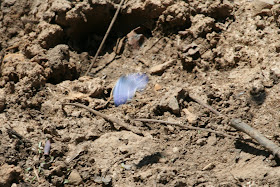
Honey Bee on Glory-of-the-Snow (March 22, 2009)
Since I posted this yesterday, I have received replies from several entomologists so I corrected this post. First, the yellow bee is actually a fly! Feral colonies of honey bees can exist in this area.
I have paid more attention to bees lately because this year I am becoming a beekeeper! When I was researching about honey bees, I wanted to find out whether the honey bee, essentially an alien, would harm the wild bees, that is replace them. Since honey bees have been with us since colonial times, it's not surprising that I didn't find out much about this issue online.

Bumble Bee (July, 2008)
So, I have been watching my favorite, the Bumble Bee, to see if my new colony of 12,000 bees arriving this Friday, April 3 would interfere with it. For a week, I have observed bumble and honey bees foraging together on my Glory-of-the-Snow tiny blue flowers. Besides these two bees, I saw two other types, both smaller than the honey bee. Even the wasps were getting along with the bees.

On this photo, you can see how the honey bee carries pollen in a pouch on his legs (or knees? Ha!) while she sucks the nectar. Both foods will be carried back to the hive.
I also inquired about where those honey bees might have come from because I understand they don't usually forage more than a mile from their hive. Honey bees can survive in the wild in our winter, especially if they find a good hollow tree, their natural nest. I since learned that a couple of farmers keep hives about 2 miles away.

Dung Fly (Scathophaga stercoraria)
My interest piqued, I went up in our back pasture looking for more bees. Instead, I found this Dung Fly feeding on cow manure.

Luckily no one saw me on my hands and knees over the cow manure (thankfully not fresh), studying these flies.

Spring Azure Butterfly in flight
While I was up in the pasture on March 22, I saw my first Spring Azure butterfly. You can only see the beautiful blue azure color as they fly. When they land, they keep their wings up and the undersides are a dull gray. I tried to capture the beautiful blue azure color but I guess my shutter speed wasn't fast enough. In a way, the photo's a lot like what you experience when you see them fly--a flash of blue.









